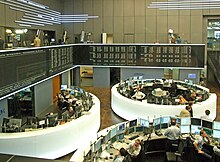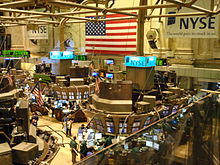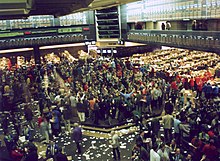Floor trading
The trading floor (also trading on or Criée trading , [ French criée , "called out"]) is in stock exchanges or commodity markets a traditional trade medium, wherein the stock broker ( lead broker ) and Trader by mutual cries and / or coordinated gestures exchange transactions to complete.
General
Occasionally the terms "ring trade" (Switzerland) or "accusation trade" ( English open outcry trading ) are used for this. The compound floor trading contains the defining word floor , on which the trading participants are during trading hours . Floor trading takes place among the trading participants through the verbal interaction of mutual loud shouting together with supporting gestures; later entries in the trading systems do not change anything. Floor trading only ceases to exist when the price is formed exclusively by electronic trading systems in automated trading . If the order parameters of a securities order are taken over by computer decisions, whereby the order is to be initiated, as well as the time, price or quantity of the order or how the order is processed after its submission with limited or no human involvement ( section 80 (2 ) WpHG ), there is no more floor trading.
Stock market jargon
In particular, the exchange participants maintain as a trade language a stock market jargon , of a summary of the purchase or sale intention - supported by gestures - expresses. It spread outside of the stock exchange also in interbank trading . "I am money at 110" means that the caller is ready to buy at the rate of 110 euros, correspondingly "I am letter 110" means willingness to sell. The purchase or sale ( English deal ) comes about through the confirmation "to you" or "from you".
history
The stock exchange emerged as an institution subject to strict rules from the market , on which trading was also carried out through verbal communication. The first stock exchange was established in Bruges in 1409 in front of the house of the founding family van der Beurse, where absent goods and bills of exchange were traded. The word stock exchange was probably derived from the purse ( Dutch beurs ). From here stock exchanges spread worldwide, in 1540 in France ( Lyon ; French bourse ) and Germany ( Augsburg stock exchange ), in 1571 in England ( London ; English exchange ) or in 1612 in the Netherlands ( Amsterdam stock exchange ; Dutch beurs ). The first commercial Paris stock exchange existed in 1639 when the functions of the commodity and stock exchange were separated. A decree of April 2, 1639 gave the dealers the designation stock traders ( French agents de change ), whose official trade was given the designation "parquet" ( French parquet ). Since then, every trading floor has been referred to as floor and trading therein as floor trading .
The Milan Stock Exchange ( Italian borsa ) was not founded until February 1808 . After 1820 floor trading was the oldest trading infrastructure in the German securities market, where the trading of promissory notes and bonds took place in special stock exchange buildings through the personal presence of market participants and their direct communication. In February 1830, the Munich Stock Exchange introduced share trading, which considerably stimulated floor trading due to its volatility . The first German stock exchange law of June 1896 made a trading floor mandatory for a long time. When founded in 1898 Chicago Mercantile Exchange (CME) met in floor trading ( English Open Outcry ) of the Chicago Board of Trade , the dealer or broker octagonal in a mostly and on the floor like platform ( English Pit ) to the desired futures or Options to trade. Each individual contract was traded in a separate pit. Although the hustle and bustle in the pits was often characterized as "hectic" or "disordered" by outsiders, precise rules governed the buying or selling procedure. For this purpose, a sophisticated communication system was developed which enabled traders to use hand signals to communicate across the entire pit and thus to act more effectively. If a pit trader wanted to buy, the backs of the hands always pointed outwards, towards the other traders. When selling, his palms were outward, facing the other traders. The seller now called the price out loud to the buyer or the buyer to the seller. The seller was the price agreed, he called generally "sold" ( English sold ). Now both dealers wrote down the other's dealer number; the deal was hereby concluded. In the middle of the pits with the best acoustics, employees of the stock exchange sat and noted the prices at which business was taking place. This happened on the basis of the announced prices in connection with "sold" or "done".
The electronicization of the stock exchange increasingly replaced floor trading from 1971, because the computer systems were used in every phase of the trading process. The first level of automation was called computer-aided floor trading , in which individual transaction phases were electronically supported. In February 1971, NASDAQ introduced a screen-based trading system that made it the first electronic exchange. This was followed by computerized trading , then came computer trading systems used and finally followed by the computer market , which does not need any floor trading. The German legislator only recognized the electronic conclusion of contracts in July 1989. These regulations were made in the Stock Exchange Act and made electronic stock exchange trading possible. In October 1990 the Handelsblatt reported that computers were taking over the German trading floor. In December 1995 the Frankfurt Stock Exchange published a “standard-interpreting administrative regulation regarding the rules for determining the exchange price in floor trading”, whereby the principle of highest execution and price continuity were to be observed.
In Switzerland the ring trade was abolished in August 1996, in Austria floor trade in 1997. In October 1998, the introduction of " Xetra Release 3" in Frankfurt enabled the electronic trading of around 2000 shares, 370 bonds and 28 stock option certificates at the expense of floor trading. He forwards the securities orders of the credit institutions directly to the stock exchange and thus into the order book of the lead broker. The Fourth Financial Market Promotion Act of July 2002 set the course for electronic price formation, which has tended to decrease the importance of floor trading in favor of electronic trading systems . After the Frankfurt Stock Exchange already traded and settled 93% of all securities electronically, floor trading was finally stopped in May 2011. The Chicago Mercantile Exchange closed its floor trading for futures in Chicago and New York City on July 2, 2015 because the proportion of contracts closed in this form had fallen to 1% of the trading volume. Options can still be traded on the floor of the CME. Termination of options trading by means of open outcry trading is currently (end of 2018) not planned.
Course formation in floor trading
The classic form of securities orders via a stockbroker differs from electronic Xetra trading in particular in that the buyer has to look for a seller himself and vice versa. The exchange prices are determined during the trading hours on a stock exchange or in the open market ( Section 24 (1) BörsG). Exchange prices must come about properly and correspond to the actual market situation of exchange trading (Section 24 (2) BörsG). According to Section 24 (3) of the BörsG, exchange prices and the underlying transactions must be made known to the trading participants in an easily accessible manner without delay and under reasonable commercial conditions. For the purpose of determining the course leads lead broker an order book ( Skontro ) in which all buy and sell orders, regardless of whether these orders a limit comprise or is not detected. According to Section 27 Paragraph 1 of the Exchange Rules of the Frankfurt Stock Exchange (BörsO; Annex I), exchange prices in floor trading are determined by the lead brokers as a percentage of the nominal amount or in euros per unit. According to § 39 BörsO, the management of the exchange publishes the prices determined. The quotation of the spot rate is the standard rate . If buyers and sellers have specified unlimited orders or precisely this single rate (or a higher rate for buy orders / a lower rate for sell orders) in their orders, they have a legal right to execution at this rate. In the case of variable quotation, on the other hand, the price is determined several times during trading hours as soon as certain minimum orders allow a turnover. The clients have no legal claim to a certain variable rate .
In the case of computer trading venues (e.g. XETRA ) or computer exchanges (e.g. SIX Swiss Exchange ), on the other hand, orders are simply searched for opposing positions and processed using the limits, regardless of the counterparty . With Xetra trading, it may happen that an order is split into several orders without incurring additional costs. The broker usually carries out the entire order together and is relatively free to make a decision - regardless of the electronic system. However, its activities are not always transparent.
Floor trading today
Today, the trading floor is only on some regional German stock exchanges represented ( Börse Berlin , Börse Stuttgart ) and yet in some commodity markets. Here the trading hours are fixed on the floor, e.g. B. from 9:00 a.m. to 2:30 p.m. (e.g. Light, Sweet Crude Oil Futures and Options), after which the trading day is over. After-hours trading takes place exclusively computerized. The world's most important floor trading exchange is the New York Stock Exchange . Floor trading is still taking place on the major futures exchanges in North America, NYMEX and CBOT , as well as on the London Metal Exchange .
Despite the decline in floor trading, the term floor is often used today as a metaphor for the stock market. Business journalists write, for example, that a company “dares to take to the floor” when they report on an IPO .
Floor trading in retail
The retail trade (such as supermarkets , shops or vending machines ), where the goods can be handed over immediately upon purchase (they are "present" in the shop), in contrast to mail order , distance selling and online trading , where between ordering and Handover is at least one working day . This floor trading is called "Platzkauf" in Switzerland.
Web links
Individual evidence
- ↑ Detlef Wienecke-Janz (ed.), Die Große Chronik-Weltgeschichte: 1204-1492 , Volume 9, 2008, p. 262
- ↑ Verlag Dr. Th. Gabler, Gabler Bank Lexikon , 1988, Sp. 1652
- ↑ Peter Nobel, International Corporate Law: Including International Capital Markets Law , Edition 4, 2002, p. 87
- ↑ The Art of Hand Signals , Trading Signals (455 Kibibyte )
- ^ Ryan Carlson, Trading Pit Hand Signals , Debrouillard Group, 2013
- ↑ Urs Fischer / Roger M Kunz, Exchange trading in Europe: facts, trends, scenarios , 2001, p. 757
- ^ Norman Schenk, Informationstechnologie und Börsensysteme , 1997, p. 3
- ↑ Peter Nobel, International Corporate Law: Including International Capital Markets Law , Edition 4, 2002, p. 87
- ↑ Handelsblatt of October 24, 1990, personal computers conquer the trading floor
- ↑ Dirk Glebe, Understanding Stock Exchange , 2008, p. 102 f.
- ↑ Frankfurter Rundschau of May 20, 2011, Frankfurter Börse: Classic floor trading ends
- ↑ Nikolaus Piper, It gets quiet in the pit , in: Süddeutsche Zeitung from May 2, 2015, p. 25
- ^ CME Group: Trading Hours
- ↑ Björn Lorenz / Petr Knobloch / Detlef Heinzel, Modernes Risk Management , 2002, p. 46
- ↑ Wirtschaftslexikon Gabler, electronic order book
- ↑ Stephan Jäger, Sales Systems for Mass Customization , 2004, p. 164




